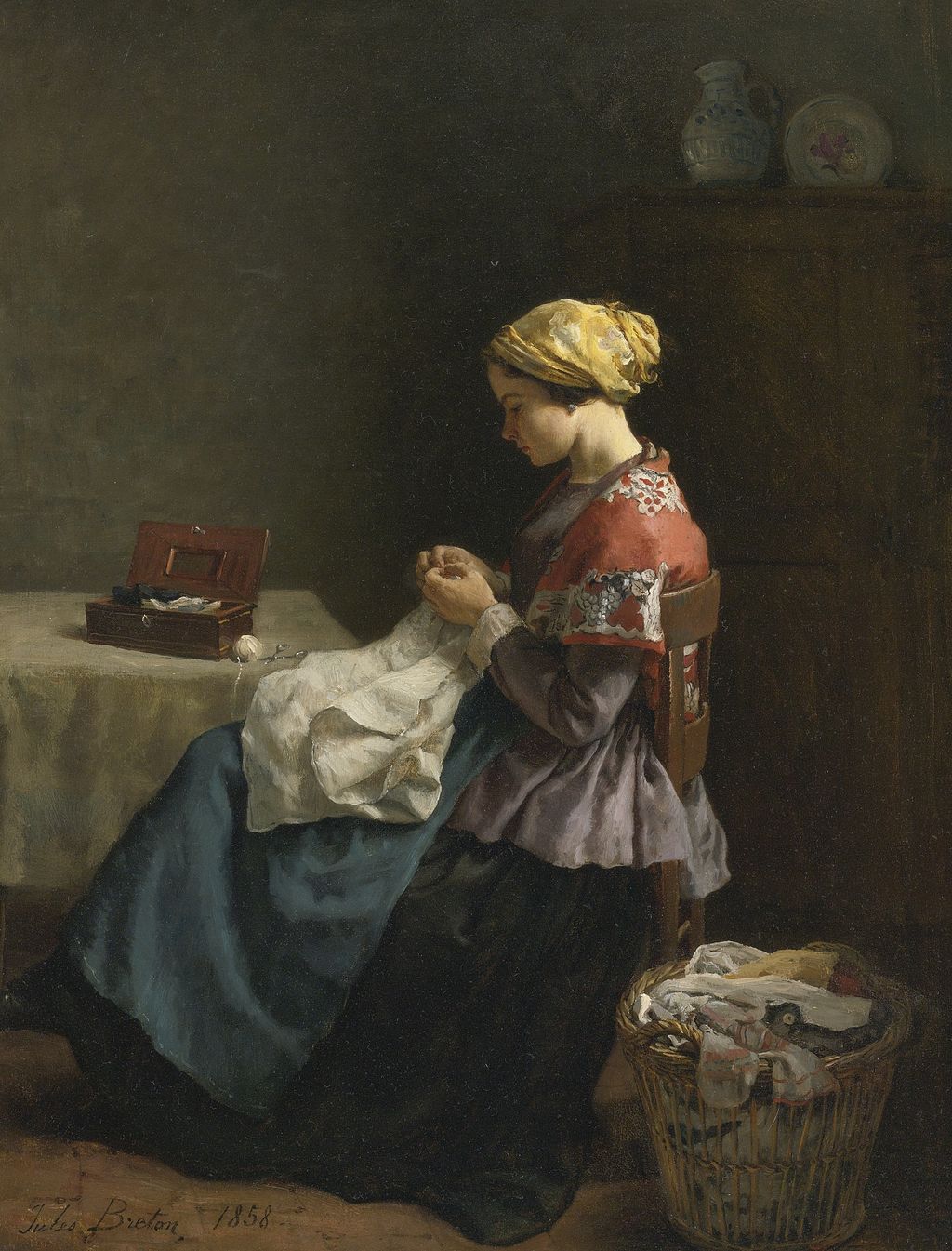Seamstress
Cliquez ici pour la version française
La Couturière | The Seamstress
The young seamstress ("La petite couturière", 1868 painting by Jules Breton, Wikimedia Commons)
La couturière, or seamstress, was a woman who made custom-made clothing using fabrics and materials, who practised sewing. In France, the predecessor of the “couturier” or “couturière” was the “tailleur”— there was no feminine equivalent of this word, since only men were allowed to make clothing (for both men and women) until 1675, with a small concession made to the tailleur’s unmarried daughters, who were allowed to make clothing for children under the age of 8 only. Today, the word “couturier” is generally reserved for men who make women’s clothing.
The first European colonists who came to New France didn’t bring a vast amount of clothing with them, and clothing wasn’t something you could buy easily. Until the 17th century, sewing tools such as needles, pins and pincushions were included in the trousseaus (trunks) of many women and girls, including the filles du roi. Most colonists made the most of their existing pieces, mending them when necessary instead of buying new. It was only the upper-class residents who could afford to employ seamstresses and tailors.
For the most part, sewing was considered a woman's occupation. She was a couturière, responsible for extending the longevity of clothing. If necessary, the seamstress could take apart an entire item of clothing, and would re-sew it into something new that could still be used. The many steps involved in making clothing from scratch (weaving, pattern making, cutting, alterations, and so forth) meant that women often worked together depending on each person’s particular skill set. Embroidery was seen as an especially valuable skill. The seamstress mended the clothing of her own household, but could also be employed by others, such as fur merchants.
A seamstress would usually learn her craft from other family members or from nuns. If she lived in an urban area, she could be hired by a tailor as an apprentice.
The surname Couturier, which survives in Canada today, actually derives from the old French couture, meaning "cultivated land", the surname of a cultivator or labourer.
"Seamstress" (2000 oil painting by Alexey Akindinov, Wikimedia Commons)
"The Seamstress" (1880 oil painting by Alexander-Hugo Bakker-Korff, Wikimedia Commons)
Known women who had this occupation: Suzanne Brown, Marguerite Callinder, Rose Calvé, Catherine Charland dit Francoeur, Marie-Angélique Chevreul Duval, Marguerite Coton, Catherine Demers dit Dessermons, Angélique-Gabrielle Duchesne, Françoise Duval, Suzanne Jouineau (Juineau) dit Larose, Marie-Anne L'Espérance, Marie-Josèphe Lafaye, Béique Lafleur, Marie-Angélique Larcher, Louise Montreuil, Catherine Patissier.
Sources:
Suzanne Gousse, Les couturières en Nouvelle-France. Leur contribution socioéconomique à une société coloniale d’Ancien Régime, Université de Montréal, April 2009, M.A. History Thesis (https://papyrus.bib.umontreal.ca/xmlui/bitstream/handle/1866/7662/Gousse_Suzanne_2009_memoire.pdf?sequence=1&isAllowed=y).
Alfred Franklin, Dictionnaire historique des arts, métiers et professions exercés dans Paris depuis le treizième siècle (Paris, H. Welter, 1906), 227.
Marc Picard, Dictionnaire des noms de famille du Canada français, (Québec, Québec: Presses de l'Université Laval, 2010), 94.
Wikipedia contributors, "Sewing," Wikipedia, The Free Encyclopedia, https://en.wikipedia.org/w/index.php?title=Sewing&oldid=866372636.


